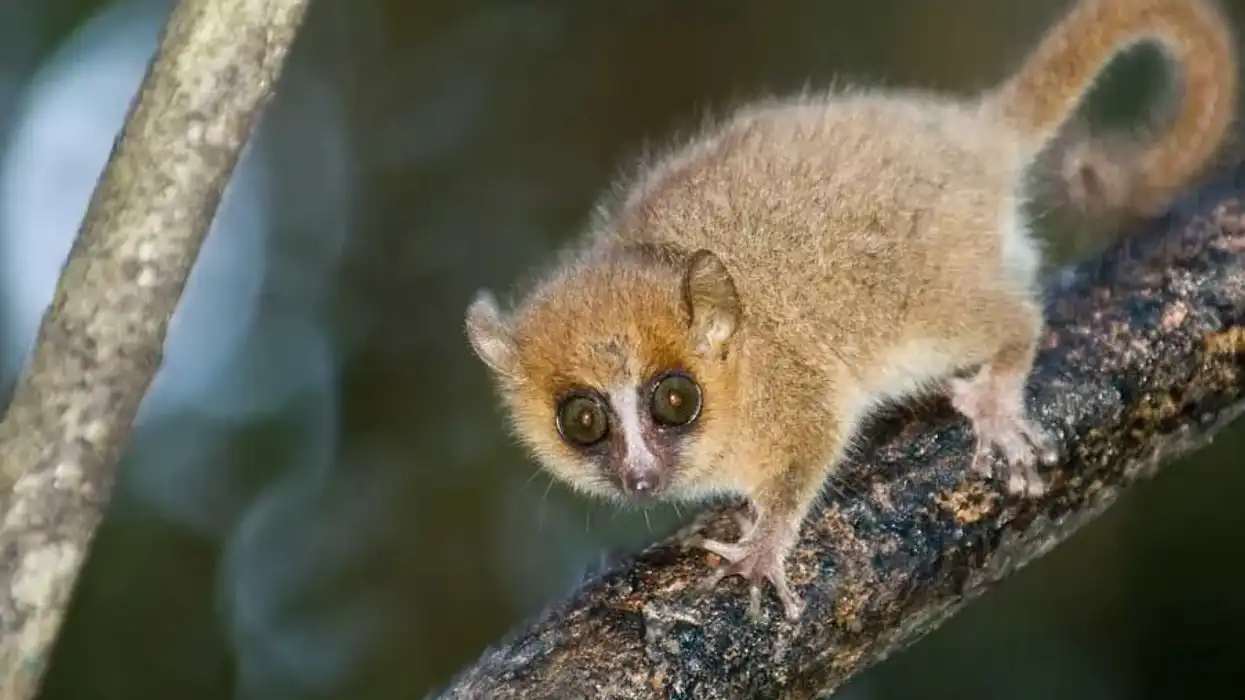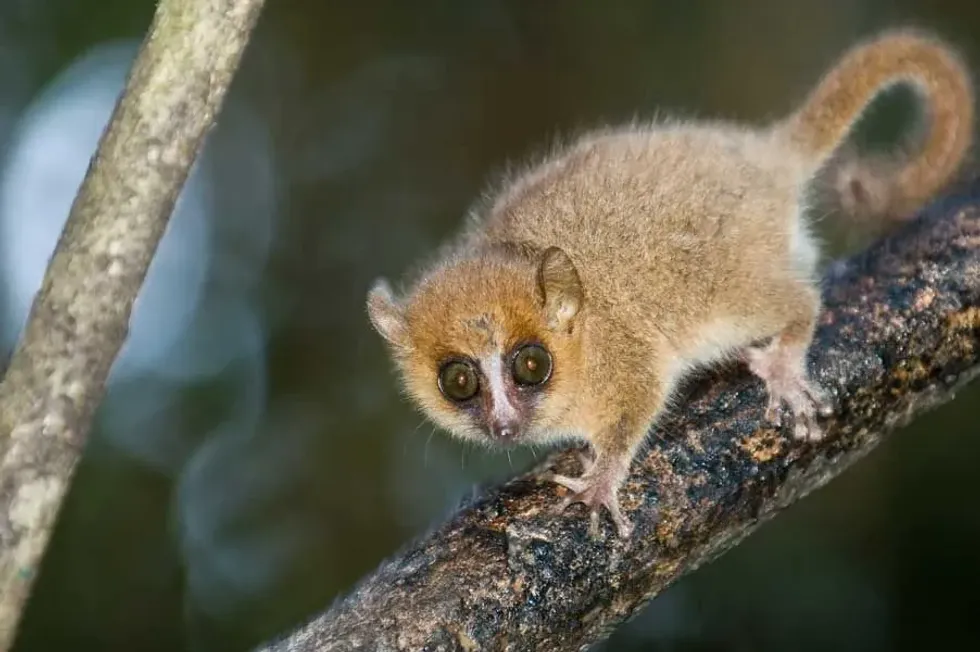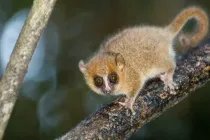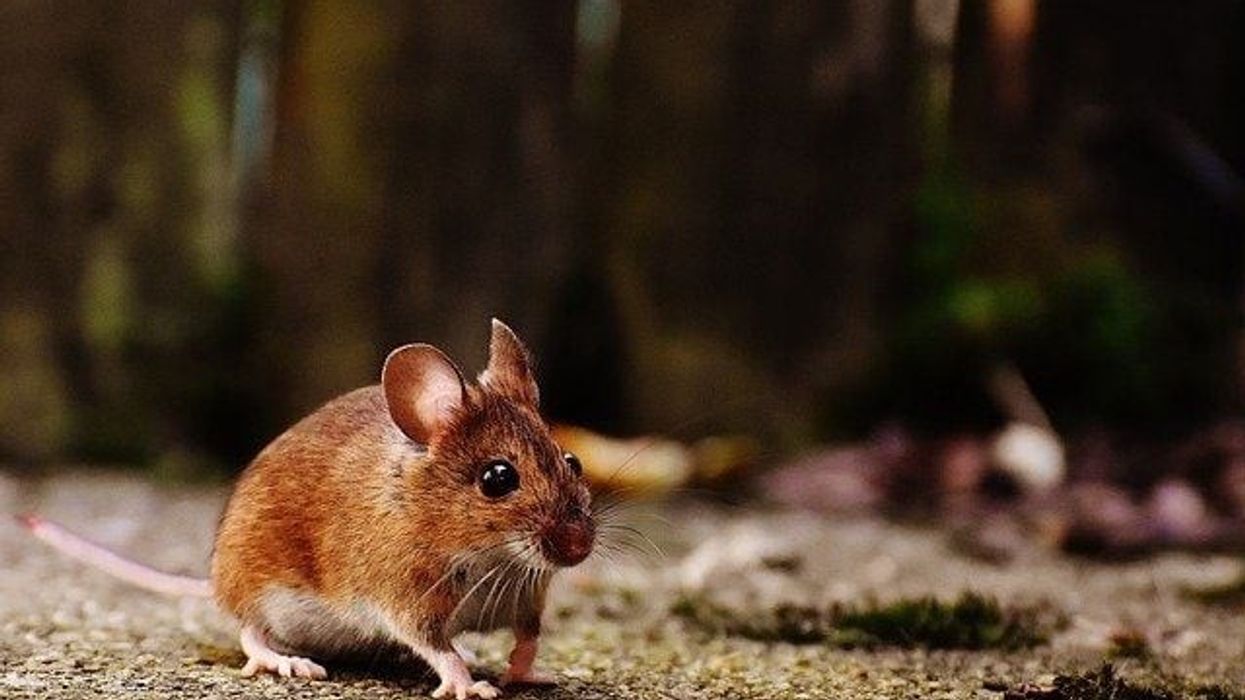Fun Gray Mouse Lemur Facts For Kids
If you ever happen to see a gray mouse lemur, Microcebus murinus, the first thing you will notice is its round, glassy, large eyes. Mouse lemurs are one of the smallest and oldest primate species in the world and gray mouse lemurs are the largest within this group.
The gray mouse lemurs are also called lesser mouse lemurs. Gray mouse lemur species is endemic to Madagascar and is a cryptic species, meaning they are hard to distinguish from other species of lemurs.
Gray mouse lemurs are arboreal (living in trees) and nocturnal (active at night) species. They get their name from their small mouse-like appearance.
Lemurs come from the Latin word 'lemures' which means 'ghost'. Mouse lemurs are active at night and their bright eerie large eyes associate them with spirits. These lesser mouse lemurs are threatened by habitat loss and illegal pet trade.
You may also check out the fact files on pygmy slow loris and aye-aye from Kidadl.
Gray Mouse Lemur Interesting Facts
What type of animal is a gray mouse lemur?
Though they have 'mouse' in their name and look very similar to a mouse, a grey mouse lemur Microcebus murinus is not a rodent and originally belongs to the primate group. They are one of the smallest primates in the world, but the largest among other mouse lemurs. Gray mouse lemurs belong to the genus Microcebus.
What class of animal does a gray mouse lemur belong to?
Gray mouse lemurs belong to the class Mammalia. They are classified as kingdom: Animalia, phylum: Chordata, class: Mammalia, order: Primates, suborder: Strepsirrhini, Family: Cheirogaleidae, Genus: Microcebus, Species: Microcebus murinus.
There are around 17 species of mouse lemurs. Other mouse lemur species are Pygmy mouse lemur (M. myoxinus), Golden-brown mouse lemur (M. ravelobensis), and Brown mouse lemur (M. rufus). Red and gray mouse lemur (M. griseorufus), and Northern Rufous mouse lemur (M. tavaratra) are also common species.
How many gray mouse lemurs are there in the world?
The exact population of gray mouse lemurs is unknown. According to IUCN, the population density varies between 167-180 per km2. The population is declining owing to various threats.
Where does a gray mouse lemur live?
Gray mouse lemur species are endemic to the Madagascar islands, Africa. Their home range is the dry deciduous forests and thorn scrubs on the western coasts (Majunga) and the south-eastern parts (Fort Dauphin) of Madagascar.
They are arboreal, meaning they live on trees. Their ideal shelter is in tree holes. They are found in five special reserves, seven national parks, and private protected forests.
What is a gray mouse lemur's habitat?
The gray mouse lemurs are very adaptable to various habitats. Some habitat types where they are found in abundance are dry deciduous forests, tropical forests, scrub jungles, eastern littoral forests, plantations, secondary forests, gallery forests, and other habitats that are degraded. Gray mouse lemurs are arboreal and live on high tree branches. They occasionally forage at ground level.
Who do gray mouse lemurs live with?
Gray mouse lemurs are solitary nocturnal foragers. They sleep in groups during the day. The females sleep in groups of two to nine individuals, while the male may sleep alone or in groups of two. A tree hole is shared between up to 15 lemurs.
How long does a gray mouse lemur live?
The lifespan of gray mouse lemur species in the wild is an average ranging from five to eight years. Meanwhile, in captivity, they have been reported to live up to 15 years.
How do they reproduce?
There is no distinct sexual dimorphism in males and females of gray mouse lemurs. Female gray mouse lemurs attain sexual maturity at 10-29 months and males at 7-19 months.
The average reproductive lifespan of a grey mouse lemur is 5 years. The breeding season starts in September. The female gray mouse lemurs undergo an estrus cycle and are receptive for 50-55 days.
They make high-frequency calls to attract the male mouse lemurs. The mating behavior exhibited by grey mouse lemurs is polyandrous, both males and females of grey mouse lemurs have multiple partners.
The female grey mouse lemur chooses her partners and mates with up to seven lemurs in a single night. They avoid male lemurs that try monogamy and choose their partners that enable a genetic diversity in the offspring.
During the breeding season, the size of male testes increases, owing to the increase in their overall body mass which acts as a successful selective trait during mating. Male gray mouse lemurs in the wild do not exhibit any visible aggression or competition.
Like all mammals, the female grey mouse lemurs give birth to young ones. The gestation period is for 54-68 days. The female usually gives birth to twins, and occasionally to three babies.
At the beginning of the monsoon, they give birth inside a leaf nest or in tree holes. The babies wean continuously for a month and become independent of the mother mouse lemur in two months. The baby gray mouse lemurs do not cling to their mother.
Closely related females grey mouse lemurs remain loosely associated after maturation, whereas males disperse from their natal region. The mortality risk is reduced by cooperative breeding, female grey mouse lemur not only shifts her offspring to other nests but also cares for other offsprings. They defend their nest as a community. The gray mouse lemurs breed well in captivity.
What is their conservation status?
The IUCN Red List classifies the conservation status of the gray mouse lemur Microcebus murinus as of Least Concern. They show a declining population trend. The major threats they face are habitat loss, the illegal pet trade, and other human activities.
Gray Mouse Lemur Fun Facts
What do gray mouse lemurs look like?
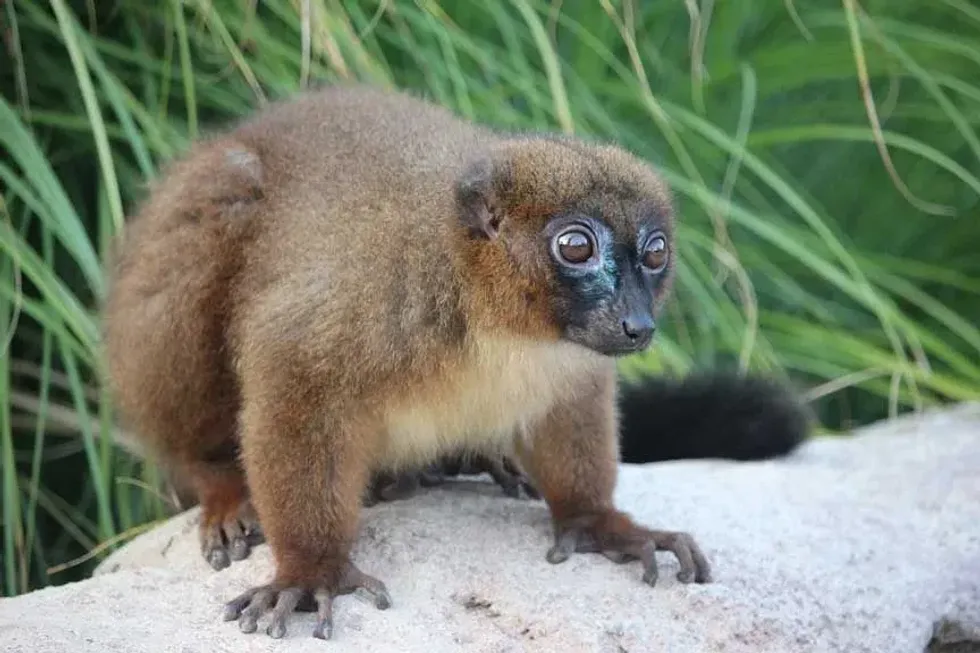
*Please note that this is an image of a gray-brown mouse lemur, a similar breed as gray mouse lemur. If you have an image of a gray mouse lemur please let us know at hello@kidadl.com.
The gray mouse lemurs are small mouse-like primates. They have long hind legs and long furry tails.
Their body is covered with brownish-gray soft fur with red undertones. The underside is light gray to beige, hands and feet are off-white, and ventral fur has white or beige patches on the belly. A not so distinguishable stripe is present on their back.
The gray mouse lemurs have a small rounded head with a short snout and large protruding oval ears. They have large eyes that help with their vision at night. They have a moist nose which may be an indicator of great smell.
The gray mouse lemur dental pattern consists of long, thin lower incisors and canines ideal for scraping gum off trees and grooming. Their lower front teeth resemble a brushing comb and are known as a dental comb.
How cute are they?
The small body and highly disproportionate large eyes of the gray mouse lemurs make them look so cute and adorable. But don't be fooled by their appearance, they will bite and attack if they feel threatened. The young ones are relatively calmer than older ones.
How do they communicate?
Gray mouse lemurs have very distinct calls from other mouse lemurs. Their vocal calls help them find their offspring, find other members of the group, for mating, or alert potential threats and distress calls.
The female gray mouse lemurs use a high pitch call to invite males for mating. The vocal range of males and females is between 10-36 kHz. Gray mouse lemurs, unlike the brown mouse lemur, use a lower frequency, shorter duration call known as a harmonic whistle.
Another mode of communication within the species is via scents. The gray mouse lemurs mark their home ranges with urine and feces.
How big is a gray mouse lemur?
The gray mouse lemurs are one of the smallest species of primates. They are also the largest species of mouse lemurs. They are so small that an entire family can fit in the palm of your hand.
The gray mouse lemurs grow at an average body length ranging from 9.8-11 in (25-28 cm). Their tail length alone accounts for 5.1-5.7 in (13 to 14.4cm). They are smaller than the world's smallest monkey, the pygmy marmoset.
How fast can a gray mouse lemur move?
The average maximum speed a gray mouse lemur can move at is 20 mph (32.1 kph).
How much does a gray mouse lemur weigh?
The average weight of an adult gray mouse lemur is 2.3 oz (67 g). For comparison, they weigh lesser than the pygmy marmoset 4.9 oz (140 g ). The weight of males and females varies with season.
They build fat reserves in the tail and hind legs to help them cope with their period of dormancy (torpor) during the cold and dry season. Their tail can increase in size up to four times its original size. During their active season, they intake food with more proteins.
What are the male and female names of the species?
There are no specific names for the male and female species of gray mouse lemurs.
What would you call a baby gray mouse lemur?
A gray mouse lemur baby is called a baby, infant, or offspring.
What do they eat?
Gray mouse lemurs forage for their food at night. They are solitary feeders. Their primary diet involves insects and fruit flowers.
They feed on fruit flower nectar, pollen, bugs, beetles, moths, cockroaches, spiders, and crickets. They also feed on small reptiles like lizards, chameleons, and small snakes like rosy boa and milk snakes. During the dry season, they feed on gums and saps.
Are they loud?
Gray mouse lemurs are very vocal and rely on verbal communication. They produce calls in the frequency range of 10-36 kHz. Sometimes they also make calls beyond the range of human hearing (0.02 to 20 kHz).
Would they make a good pet?
The gray mouse lemurs look adorable enough for us to want them as pets. But adult wild mouse lemurs can be aggressive and will bite humans. Females are the most aggressive.
Did you know...
The gray mouse lemur’s retinas have a reflective layer called the ‘tapetum’ that reflects light and helps improve their night vision. Gray mouse lemur has one claw-like nail and the rest of the digits have flat nails. This helps them climb the tree and have a tight grasp.
Why is gray mouse lemur endangered?
The gray mouse lemurs are listed in Appendix 1 by the Convention on International Trade in Endangered Species (CITES) in 1975. This prohibits them to be used for international trade and commercial use.
Their population is rapidly declining due to habit loss from agriculture, mining and cattle grazing. The gray mouse lemurs along with other species of mouse lemurs are also captured alive for the illegal pet trade.
Parasites (nematodes and protozoans) on their body is also an added cause for stress and mortality. Due to deforestation, the ability to find tree holes has also reduced, leaving them to nest in smaller tree holes.
This has considerably reduced their body size from its average. Extended cold weather due to climate change increases the length of their torpor, forcing them to starve for a longer period. This has also been a factor in reducing population and increasing mortality.
Can you keep gray mouse lemurs as pets?
It is not advisable to keep exotic endangered animals as pets. The first reason being, it is illegal to keep them as pets. Another reason is, they are exotic and the availability of trained vets to treat them will be rare. They belong to Madagascar islands and would find it hard to adapt to colder or harsh climate areas.
Here at Kidadl, we have carefully created lots of interesting family-friendly animal facts for everyone to discover! Learn more about some other mammals from our mangabey facts and ring-tailed lemur facts pages.
You can even occupy yourself at home by coloring in one of our free printable Gray Mouse Lemur coloring pages.
We Want Your Photos!
More for You
See All
Doctorate specializing in Veterinary Medicine

Oluniyi AkandeDoctorate specializing in Veterinary Medicine
With an accomplished background as a Veterinarian, SEO content writer, and public speaker, Oluniyi brings a wealth of skills and experience to his work. Holding a Doctor of Veterinary Medicine degree from the University of Ibadan, he provides exceptional consulting services to pet owners, animal farms, and agricultural establishments. Oluniyi's impressive writing career spans over five years, during which he has produced over 5000 high-quality short- and long-form pieces of content. His versatility shines through as he tackles a diverse array of topics, including pets, real estate, sports, games, technology, landscaping, healthcare, cosmetics, personal loans, debt management, construction, and agriculture.
Disclaimer
1) Kidadl is independent and to make our service free to you the reader we are supported by advertising. We hope you love our recommendations for products and services! What we suggest is selected independently by the Kidadl team. If you purchase using the Buy Now button we may earn a small commission. This does not influence our choices. Prices are correct and items are available at the time the article was published but we cannot guarantee that on the time of reading. Please note that Kidadl is a participant in the Amazon Services LLC Associates Program, an affiliate advertising program designed to provide a means for sites to earn advertising fees by advertising and linking to Amazon. We also link to other websites, but are not responsible for their content.
2) At Kidadl, we strive to recommend the very best activities and events. We will always aim to give you accurate information at the date of publication - however, information does change, so it’s important you do your own research, double-check and make the decision that is right for your family. We recognise that not all activities and ideas are appropriate for all children and families or in all circumstances. Our recommended activities are based on age but these are a guide. We recommend that these ideas are used as inspiration, that ideas are undertaken with appropriate adult supervision, and that each adult uses their own discretion and knowledge of their children to consider the safety and suitability. Kidadl cannot accept liability for the execution of these ideas, and parental supervision is advised at all times, as safety is paramount. Anyone using the information provided by Kidadl does so at their own risk and we can not accept liability if things go wrong.
3) Because we are an educational resource, we have quotes and facts about a range of historical and modern figures. We do not endorse the actions of or rhetoric of all the people included in these collections, but we think they are important for growing minds to learn about under the guidance of parents or guardians.
